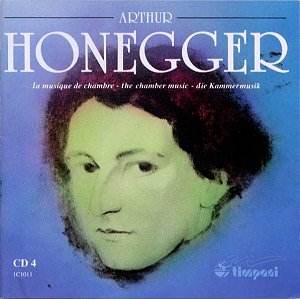|
|
Search MusicWeb Here |
|
 |
||
|
Founder:
Len Mullenger (1942-2025) Editor
in Chief:John Quinn
|
|
|
Search MusicWeb Here |
|
 |
||
|
Founder:
Len Mullenger (1942-2025) Editor
in Chief:John Quinn
|
 |
Arthur HONEGGER (1892-1955)
String Quartet No. 1 (1919?) String Quartet No. 2 (1935) String Quartet No. 3 (1936) Pâques … New York* (1924) Quatuor Ludwig Recorded September-October 1991, Eglise Evangélique, St Pierre, Paris |
| CD available for post-free online mail-order or you may download individual tracks. For some labels you can download the entire CD with a single click and make HUGE savings. The price you see is the price you pay! The full booklet notes are available on-line. | |
|
NOTE • Click on the button and you can buy the disc or read the booklet details • You can also access each track which you may then sample or down load. • Further Information. |
|
|
Arthur Honegger was born in Le Havre of Swiss parents, and studied at the Zürich and Paris Conservatoires. His early works began to make his reputation in Paris, and he became famous around 1920 as a member of the group of composers called Les Six. His artistic outlook, however, tended to be at odds with their Satie-inspired views, since he was more naturally drawn towards a serious expression: "I have no taste for the fairground, nor for the music hall, but, on the contrary, a taste for chamber music in its most serious and austere form."
There can be no more telling evidence of Honegger's musical preferences, as outlined in that quotation, than his three string quartets. The first is an early work, in fact. It even pre-dates his relationship with Cocteau and Les Six, and was the result of long and laborious toil, since he worked on it across a period of more than four years. The uncompromising nature of the style, which is very much 'young man's music', is heralded by the opening movement, marked 'violent and tormented'. Now there's a challenge to the players, if ever there was one. And the talented members of the Quatuor Ludwig respond with both commitment and enthusiasm, creating real intensity of expression through their carefully prepared performance (TRACK 1: 0.00). The Timpani recording is also most helpful, at once atmospheric and refined.
If anything the Adagio slow movement of the First Quartet is even harder to bring off. This is because its thirteen minute span requires such command of line and phrasing, such quality of intonation (TRY TRACK 2: 3.03). There is no problem as far as the latter is concerned, though I do wonder if the tensions are quite maintained across the whole span of the movement. But Honegger certainly asked for trouble here, and the demands are probably greater on the listener than on the players, given that they are talented enough to tackle the work in the first place.
The Quartet No. 2 of 1935 is an altogether greater work, in fact I would class it among the finest of 20th century string quartets. For a direct impression the Allegro marcato finale is hard to beat. It immediately sets up a strong momentum, against which events occur, and there is also a clear sense of development and direction (TRACK 6: 0.00). The performance is absolutely splendid, and idiomatically played too. This is the high point of the collection, because it is the high point of Honegger's achievement in this field.
The Third Quartet followed the following year, and this too is an inspired composition. It was commissioned by the American patroness Elizabeth Sprague Coolidge and first performed in October 1937. This too is a masterpiece, and in his eloquent insert note the Honegger expert Harry Halbreich claims this to be 'even finer than its predecessor': high praise indeed. Another densely argued and serious piece, this again taxes the technique and concentration of the players, and once more the Ludwig ensemble emerges with the utmost credit.
The fourth and last piece on the agenda also has an American connection. Easter in New York is a short song-cycle for mezzo-soprano and string quartet, and very beautiful it is too. There are religious connotations, including in the third of three settings a treatment of the Dona nobis pacem (TRACK 12: 0.00). Halbreich rightly regrets the music's neglect, but in truth compositions for this combination are not easy to promote. The title refers to the work's premiere and publication, which took place in 1924; the music reached Europe two years later. Fusako Kondo proves a capable singer, though it would be interesting to compare her interpretation against others, if it were only possible.
This collection serves Honegger's cause very well indeed. Not only is the music thoroughly representative of his strengths as a composer, the performances respond convincingly to the many challenges the music poses. With excellent documentation and full texts and translations, this is a commendable achievement.
Terry Barfoot |
| ADDITIONAL INFORMATION •
You can sample only 30 seconds (or 15% if that is longer) of a given track. Select from the View tracks list. Each sample will normally start from the beginning but you can drag the slider to any position before pressing play. • PLEASE NOTE: If you are behind a firewall and the sound is prematurely terminated you may need to register Ludwig as a trusted source with your firewall software.
•You will need Quicktime to hear sound samples. Get a free Quicktime download here • If you cannot see the "Sample All Tracks" button you need to download Flash from here.
|
|
|
Return to Index |